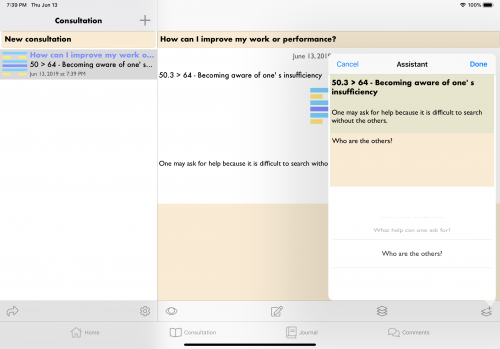Interpreting two changing lines: Mystery and Confusion
https://www.youtube.com/watch?v=ryiq2PxHAJg
It used to work...
The traditional way to interpret an hexagram is to read the comments on the hexagram, on the transformation and the comment for each changing line (either at the end or before the transformation). I have obtained decent results by following this method, specially by using follow-up questions.
Here is an example reading, about renewable energy, with two changing lines: 13.1.4
[13 > 53]


The formation
13 - Company
Making oneself available. Not taking one's own opinions into account. General agreement is impossible.
13.1 - We were lost, but we will meet later.
13.4 - Losing one's bitterness.
As interpreted, the first line would design renewable energy ( We were lost, but we will meet later.) and the line four would design the loss of bitterness obtained by abandoning coal. The hexagram 53 is about associating to overcome constraints, on the follow-up question about the constraints the oracle commented 35.6, which I interpreted hastily, now I think that it's probably about the dislike for coal.
However, while the interpretation can be discussed, this hexagram with two changing lines does not seem to cause any major issue. This is a favorable case.
The technique employed here to interpret is what I call the pivot. The pivot is renewable energy at line 1, then we use the pivot to get an advice. So it becomes something like "renewable energy makes things less bitter".
What is the problem?
The problem is that there were always readings that we could not interpret. Here is an example:
[38 > 51]


The formation
38 - Misunderstanding
One must revisit a misunderstanding if they want to dispel it. If needed, one can seek advice. One may abandon the small differences.
38.2 - One comes upon someone they know who had taken distance.
Here, 38.2 and 38.6 are "good" lines. How can they produce a shock? It does not seem to make sense at first glance. Maybe with followup questions we could determine the reason on a specific case. However, I am not working on followup questions actually, since I am asking the oracle to comment multiple changing lines.
Naturally, there are similar issues even with a single line change, for example:
[4 > 23]


Situation
When someone is welcoming and a patient teacher, they are trusted.
This line can represent a bag, or the stomach that digests everything. After carrying so many things, fatigue ensues, thus the erosion of hexagram 23.
Likewise, we can think that 38.2.6 is not understood well enough. But I have started studying comments on the situation with the oracle, and the outcome is quite difficult to understand.
[1 > 33]


Situation
1 > 33 - Indecision
One needs to listen before asking questions.
The formation
1 - Evolution
Changing to obtain quality work.
1.1 - Inexperience - One is still too weak to act.
1.2 - One has a strong potential and learns.
That one was a good start. We can see a relation between indecision, inexperience and learning.
[1 > 6]


Situation
1 > 6 - Waiting for a solution
One prepares to stop to help.
The formation
1 - Evolution
Changing to obtain quality work.
1.1 - Inexperience - One is still too weak to act.
1.3 - After a sustained activity, one questions themself.
We can understand the stop with the hexagram 6. The preparation cannot be understood, and neither the help. Here someone is confronted to an issue that they cannot solve. This comment makes sense anyway, I have googled this reading and found this thread at onlineclarity among the first results. The question was what is preventing me from manifesting this dream?
When asked for clarification, the oracle answered 34.3: One refrains until others go out.
If you had asked me before I study this situation with the oracle, what was the meaning of this, I would have said something like: "Someone is too weak to stop acting", "After multiple tries, someone realizes that they can't do anything" or "Someone is too weak to understand that they should stop". The pivot technique does not seem to work very well here. If you think that this is confusing, wait for the next example:
[1 > 57]


Situation
1 > 57 - Giving up wanting
One waits until the others give up.
The formation
1 - Evolution
Changing to obtain quality work.
1.1 - Inexperience - One is still too weak to act.
1.4 - One can confront the problems.
In the making
57 - Answer
One goes after being approached.
By reading the lines, and using the pivot technique, we can think of either "One is inexperienced but they can confront the problem", "One is too inexperienced to confront the problems", or that "Someone can confront the problems caused by the inexperience of others."
And the comment on the situation is nothing of that, except maybe the third way. I have googled again and found this thread still at onlineclarity. The question was: could Y be the right partner for me?
I have already mentioned 1.1.6 in a previous post, so I'll finish with 1.1.5:
[1 > 50]


Situation
One gives up working because they have sought too quickly instead of preparing.
The formation
1 - Evolution
Changing to obtain quality work.
1.1 - Inexperience - One is still too weak to act.
1.5 - One has understood the needs of the times.
To make a relation between the line comments and the comment on the situation we need to read the fifth line first since 1.5 traditionally shows someone who is working a lot.
However these considerations do not help us much in regard with the interpreation of 38.2.6
Transitional Sequences
An alternate possibility is to read the transitional sequences. They may give interesting results.
For 1 > 50, we can examine the two transitional sequences:
Raising Transitional Sequence
 1.1
1.1 44.5
44.5
1.1 - One is still too weak to act.
44.5 - One protects those who are not ready yet with patience, until one is satisfied.
Descending Transitional Sequence
 1.5
1.5 14.1
14.1
1.5 - One has understood the needs of the times.
14.1 - One must prepare themself before making the move.
While the first one does not seem to make much sense in regard with the comment on the situation, the second one seems to ring something. Naturally we need to be very careful.
Let's examine the descending transitional sequence for 38.2.6:
 38.6
38.6 54.2
54.2
38.6 - One wanted to take the other away from them, then refrains because the latter comes to ask friendly questions.
54.2 - When others don't help, one can leave them.
Then we can see a real shock.
Conclusion
The top to bottom approach seems to give the best results, either when interpreting the lines directly or using the transitional sequences. However, no approach is entirely satisfying so far, since we have seen with 13.1.4 that the reading has been interpreted from the bottom to the top and it made sense.

